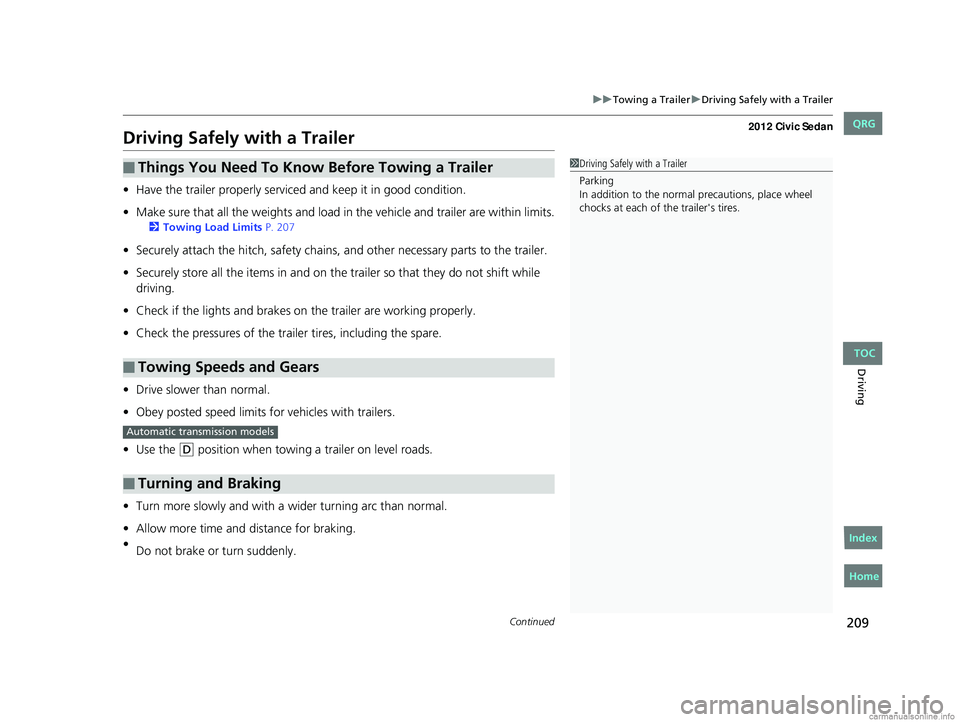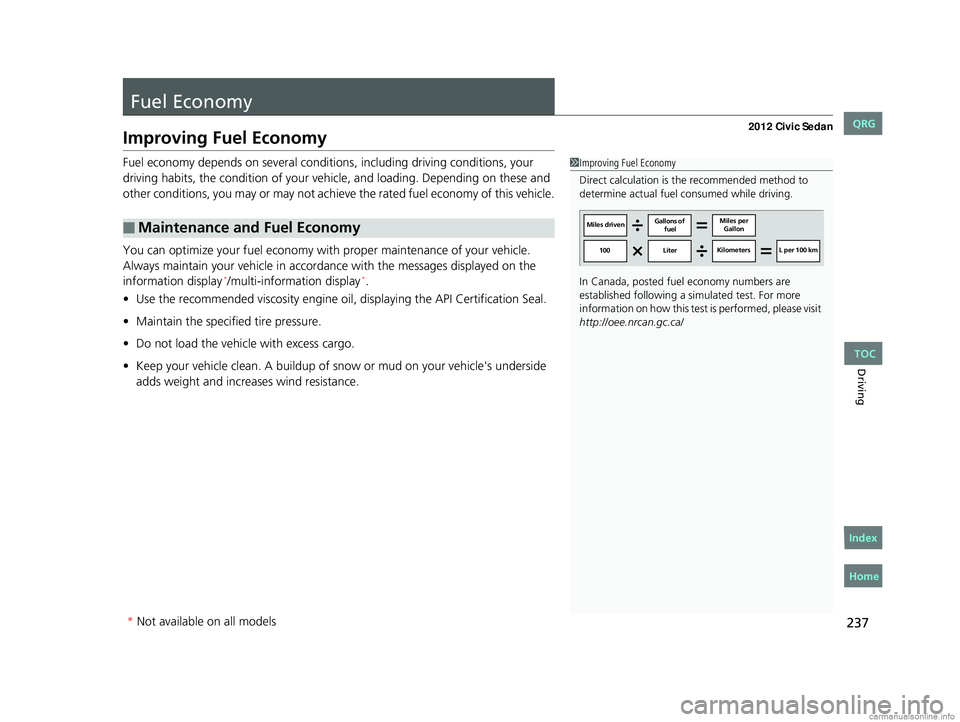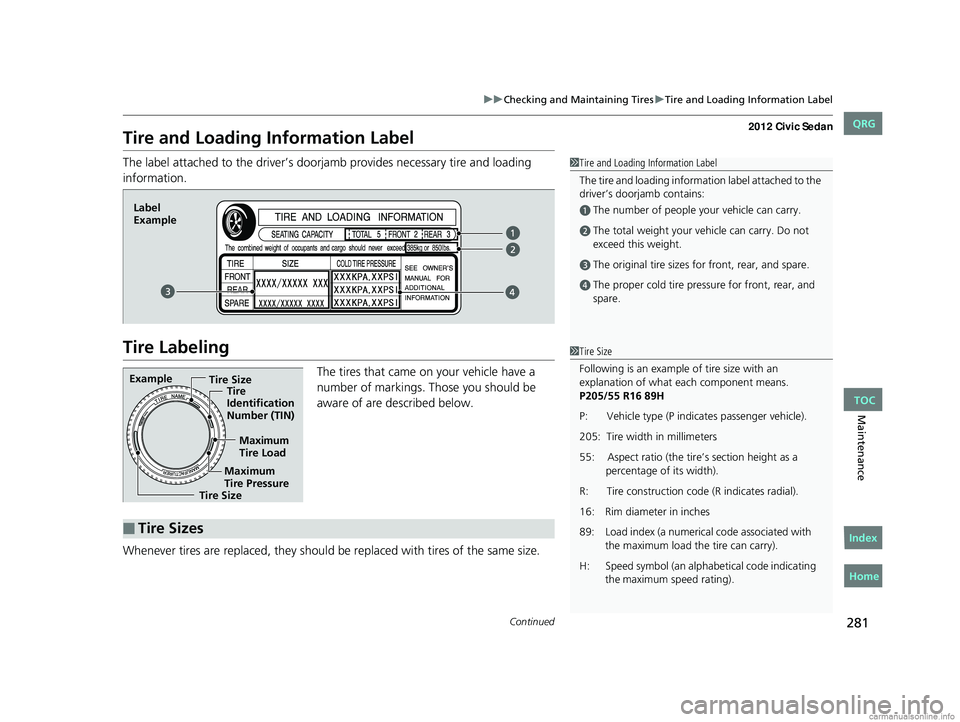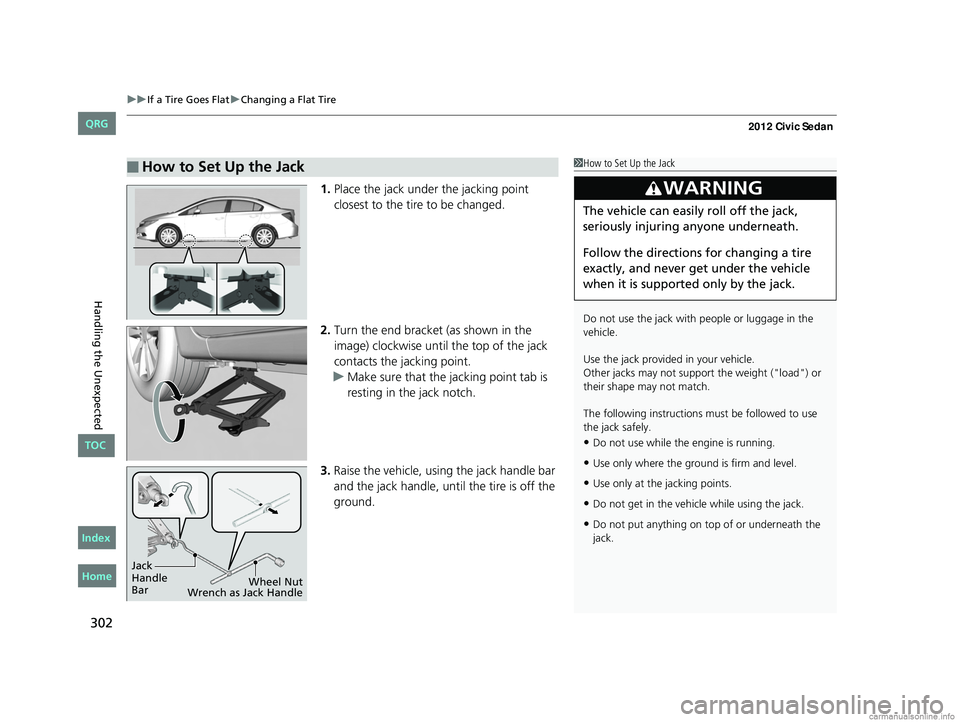Page 210 of 345

209
uuTowing a Trailer uDriving Safely with a Trailer
Continued
Driving
Driving Safely with a Trailer
• Have the trailer properly servic ed and keep it in good condition.
• Make sure that all the weights and load in the vehicle and trailer are within limits.
2Towing Load Limits P. 207
•Securely attach the hitch, safety chains, and other necessary parts to the trailer.
• Securely store all the items in and on the tra iler so that they do not shift while
driving.
• Check if the lights and brakes on the trailer are working properly.
• Check the pressures of the traile r tires, including the spare.
• Drive slower than normal.
• Obey posted speed limits fo r vehicles with trailers.
• Use the
(D position when towing a trailer on level roads.
• Turn more slowly and with a wider turning arc than normal.
• Allow more time and distance for braking.
• Do not brake or turn suddenly.
■Things You Need To Know Before Towing a Trailer
■Towing Speeds and Gears
■Turning and Braking
1Driving Safely with a Trailer
Parking
In addition to the normal precautions, place wheel
chocks at each of the trailer's tires.
Automatic transmission models
CIVIC 4D-31TR3600.book 209 ページ 2011年2月14日 月曜日 午後2時51分
TOC
Home
QRG
Index
Page 238 of 345

237
Driving
Fuel Economy
Improving Fuel Economy
Fuel economy depends on several conditions, including driving conditions, your
driving habits, the condition of your vehicle, and loading. Depending on these and
other conditions, you may or may not achieve the rated fuel economy of this vehicle.
You can optimize your fuel economy with proper maintenance of your vehicle.
Always maintain your vehicle in accordance with the messages displayed on the
information display
*/multi-information display*.
• Use the recommended viscosity engine oil, displaying the API Certification Seal.
• Maintain the specified tire pressure.
• Do not load the vehicle with excess cargo.
• Keep your vehicle clean. A buildup of snow or mud on your vehicle's underside
adds weight and increases wind resistance.
■Maintenance and Fuel Economy
1Improving Fuel Economy
Direct calculation is the recommended method to
determine actual fuel consumed while driving.
In Canada, posted fuel economy numbers are
established following a simulated test. For more
information on how this test is performed, please visit
http://oee.nrcan.gc.ca/
Miles driven Gallons of
fuel Miles per
Gallon
100 LiterKilometers L per 100 km
* Not available on all models
CIVIC 4D-31TR3600.book 237 ページ 2011年2月14日 月曜日 午後2時51分
TOC
Home
QRG
Index
Page 282 of 345

281
uuChecking and Maintaining Tires uTire and Loading Information Label
Continued
Maintenance
Tire and Loading Information Label
The label attached to the driver’s doorj amb provides necessary tire and loading
information.
Tire Labeling
The tires that came on your vehicle have a
number of markings. Those you should be
aware of are described below.
Whenever tires are replaced, they should be replaced with tires of the same size.
1Tire and Loading Information Label
The tire and loading informat ion label attached to the
driver’s doorjamb contains:
aThe number of people your vehicle can carry.
bThe total weight your vehicle can carry. Do not
exceed this weight.
cThe original tire sizes for front, rear, and spare.
dThe proper cold tire pressure for front, rear, and
spare.
Label
Example
Example Tire Size
Tire
Identification
Number (TIN)
Maximum
Tire Load
Maximum
Tire Pressure
Tire Size
■Tire Sizes
1 Tire Size
Following is an example of tire size with an
explanation of what each component means.
P205/55 R16 89H
P: Vehicle type (P indi cates passenger vehicle).
205: Tire width in millimeters.
55: Aspect ratio (the tire’s section height as a percentage of its width).
R: Tire construction code (R indicates radial).
16: Rim diameter in inches.
89: Load index (a numerical code associated with
H: Spe ed symb ol ( an alphabeti cal co de indicati ng
CIVIC 4D-31TR3600.book 281 ページ 2011年2月14日 月曜日 午後2時51分
TOC
Home
QRG
Index
the maximum speed ra. ting). the maximum load the tire can carry).
Page 303 of 345

uuIf a Tire Goes Flat uChanging a Flat Tire
302
Handling the Unexpected
1. Place the jack under the jacking point
closest to the tire to be changed.
2. Turn the end bracket (as shown in the
image) clockwise until the top of the jack
contacts the jacking point.
u Make sure that the jacking point tab is
resting in the jack notch.
3. Raise the vehicle, using the jack handle bar
and the jack handle, until the tire is off the
ground.
■How to Set Up the Jack1How to Set Up the Jack
Do not use the jack with people or luggage in the
vehicle.
Use the jack provided in your vehicle.
Other jacks may not support the weight ("load") or
their shape may not match.
The following instructions must be followed to use
the jack safely.
•Do not use while the engine is running.
•Use only where the ground is firm and level.
•Use only at the jacking points.
•Do not get in the vehicle while using the jack.
•Do not put anything on top of or underneath the
jack.
3WARNING
The vehicle can easily roll off the jack,
seriously injuring anyone underneath.
Follow the directions for changing a tire
exactly, and never get under the vehicle
when it is supported only by the jack.
Jack
Handle
Bar Wheel Nut
Wrench as Jack Handle
CIVIC 4D-31TR3600.book 302 ページ 2011年2月14日 月曜日 午後2時51分
TOC
Home
QRG
Index
Page 322 of 345
321
Handling the Unexpected
Emergency Towing
Call a professional towing service if you need to tow your vehicle.
■Flat bed equipment
The operator loads your vehicle on the back of a truck.
This is the best way to transport your vehicle.
■Wheel lift equipment
The tow truck uses two pivoti ng arms that go under the front tires and lift them off
the ground. The rear tires remain on the ground. This is an acceptable way to
tow your vehicle.
1 Emergency Towing
NOTICE
Trying to lift or tow your vehicle by the bumpers will
cause serious damage. The bumpers are not designed
to support the vehicle's weight.
NOTICE
Improper towing such as towing behind a
motorhome or other motor vehicle can damage the
transmission.
Never tow your vehicle with just a rope or chain.
It is very dangerous, since ropes or chains may shift
from side to side or break.
CIVIC 4D-31TR3600.book 321 ページ 2011年2月14日 月曜日 午後2時51分
TOC
Home
QRG
Index
Page 325 of 345

324
Information
Specifications
■Vehicle Specifications
*1: DX, LX and HF models
*2: EX and EX-L models
ModelHonda Civic 4-Door
No. of Passengers:
Front 2
Rear 3
Total 5
Weights:Gross Vehicle
Weight Rating U.S.: 3,660 lbs (1,660 kg)*1
Canada: 1,660 kg*1
U.S.: 3,792 lbs (1,720 kg)*2
Canada: 1,720 kg*2
Gross Axle Weight
Rating (Front)U.S.: 1,985 lbs (900 kg)*1
Canada: 900 kg*1
U.S.: 2,029 lbs (920 kg)*2
Canada: 920 kg*2
Gross Axle Weight
Rating (Rear)U.S.: 1,742 lbs (790 kg)*1
Canada: 790 kg*1
U.S.: 1,786 lbs (810 kg)*2
Canada: 810 kg*2
Air Conditioning:
Refrigerant Type HFC-134a (R-134a)
Charge Quantity 13.2 – 15.0 oz (375 – 425 g)
Lubricant Type SP-10
1.8 ℓ engine models■Engine Specifications
■ Fuel
■ Battery
■ Washer Fluid
Displacement110 cu-in (1,798 cm3)
Spark Plugs NGK DILZKR7B11GS
DENSO DXU22HCR-D11S
Fuel:
TypeUnleaded gasoline, Pump octane number
of 87 or higher
Fuel Tank Capacity 13.2 US gal (50 ℓ)
Capacity/Type36AH(5)/45AH(20)
36AH(5)/47AH(20)
38AH(5)/47AH(20)
Tank CapacityU.S.: 2.6 US qt (2.5 ℓ)
Canada: 4.8 US qt (4.5 ℓ)
■ Light Bulbs
*3: Not available on all models
Headlights (Low Beam)51W (HB4)
Headlights (High Beam) 60W (HB3)
Front Turn Signal/Parking/Side
Marker Lights28/8W
Brake/Taillights 21/5W
Back-Up Lights21W
Rear Turn Signal Lights 21W (Amber)
Rear Side Marker Lights3CP
High-Mount Brake Light 21W
Rear License Plate Light5W
Trunk Light 5W
Interior LightsMap Lights*38WCeiling Light8W
CIVIC 4D-31TR3600.book 324 ページ 2011年2月14日 月曜日 午後2時51分
TOC
Home
QRG
Index
Page 327 of 345

326
uuSpecifications u
Information
■Vehicle Specifications
ModelHonda Civic 4-Door
No. of Passengers:
Front 2
Rear 3
Total 5
Weights:Gross Vehicle
Weight Rating U.S.: 3,924 lbs (1,780 kg)
Canada: 1,780 kg
Gross Axle Weight
Rating (Front)U.S.: 2,116 lbs (960 kg)
Canada: 960 kg
Gross Axle Weight
Rating (Rear)U.S.: 1,830 lbs (830 kg)
Canada: 830 kg
Air Conditioning:
Refrigerant Type HFC-134a (R-134a)
Charge Quantity 13.2 – 15.0 oz (375 – 425 g)
Lubricant Type SP-10
2.4 ℓ engine models■ Engine Specifications
■ Fuel
■ Battery
■ Washer Fluid
Displacement144 cu-in (2,354 cm3)
Spark Plugs NGK ILZKR7B-11S
DENSO SXU22HCR11S
Fuel:
TypeUnleaded gasoline, Pump octane number
of 91 or higher
Fuel Tank Capacity 13.2 US gal (50 ℓ)
Capacity/Type38AH(5)/47AH(20)
Tank CapacityU.S.: 2.6 US qt (2.5 ℓ)
Canada: 4.8 US qt (4.5 ℓ)
■ Light Bulbs
Headlights (Low Beam)51W (HB4)
Headlights (High Beam) 60W (HB3)
Fog Lights55W (H11)
Front Turn Signal/Parking/Side
Marker Lights 28/8W
Brake/Taillights21/5W
Back-Up Lights 21W
Rear Turn Signal Lights21W (Amber)
Rear Side Marker Lights 3CP
High-Mount Brake LightLED
Rear License Plate Light 5W
Trunk Light5W
Interior Lights Map Lights 8W
Ceiling Light 8W
CIVIC 4D-31TR3600.book 326 ページ 2011年2月14日 月曜日 午後2時51分
TOC
Home
QRG
Index
Page:
< prev 1-8 9-16 17-24